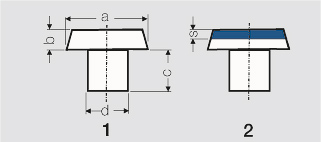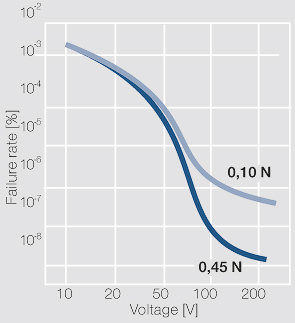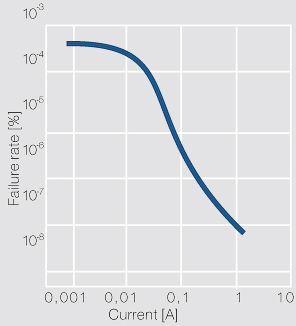Difference between revisions of "General Rules for Dimensioning of Contacts"
From Electrical Contacts
(→6.4.6 General Rules for Dimensioning of Contacts) |
(→6.4.6 General Rules for Dimensioning of Contacts) |
||
| Line 118: | Line 118: | ||
*'''Failure Probability of Single and Double (Bifurcated) Contacts''' (according to Thielecke) | *'''Failure Probability of Single and Double (Bifurcated) Contacts''' (according to Thielecke) | ||
| + | |||
{| class="twocolortable" style="text-align: left; font-size: 12px;width:40%" | {| class="twocolortable" style="text-align: left; font-size: 12px;width:40%" | ||
| Line 135: | Line 136: | ||
| | | | ||
|2 x 10<sup>-8</sup> | |2 x 10<sup>-8</sup> | ||
| + | |- | ||
| + | |0.1 | ||
| + | |2 x 10<sup>-3</sup> | ||
| + | |4 x 10<sup>-5</sup> | ||
| + | |8 x 10<sup>-5</sup> | ||
| + | |8 x 10<sup>-9</sup> | ||
| + | | | ||
| + | |0.2 | ||
| + | |1 x 10<sup>-4</sup> | ||
| + | |8 x 10<sup>-6</sup> | ||
| + | |4 x 10<sup>-6</sup> | ||
| + | |4 x 10<sup>-8</sup> | ||
| + | | | ||
| + | |0.3 | ||
| + | |5.5 x 10<sup>-6</sup> | ||
| + | |1.5 x 10<sup>-6</sup> | ||
| + | |1.8 x 10<sup>-7</sup> | ||
| + | |3.2 x 10<sup>-10</sup> | ||
|} | |} | ||
Revision as of 15:30, 7 April 2014
6.4.6 General Rules for Dimensioning of Contacts
- Recommended Minimum Contact Forces at Slightly Sliding Contact Make:
| Gold | 0.03 N |
| Silver | 0.1 N |
| Tungsten | 0.5 N |
- Contact Force Recommendations:
| Signal relays | ≥ 3 cN |
| AC power relays | ≥ 20 cN |
| Automotive relays | ≥ 20 cN |
| Motor switches (Contactors) (Silver – Metal oxide contacts) |
0.05 - 0.08 N/A |
| Power switches | 0.1 - 0.2 N/A |
| Connectors (Gold coating) |
≥ 30 cN/contact element |
| Connectors (Silver coating) |
≥ 50 cN/contact element |
| Connectors (Tin coating) |
≥ 1 N/contact element |
- General Rules for Dimensioning of Contact Rivets
| Dimensioning | Solid Rivets (1) | Composite Rivets (2) |
|---|---|---|
| a : d | 1.5 : 1 bis 2.5 : 1 | 2 : 1 bis 2.5 : 1 |
| a : b | 2.5 : 1 bis 10 : 1 | 3 : 1 bis 5 : 1 |
| c : b | ≥ 1 : 1 | ≥ 1 : 1 |
| b : s | ≥ 2 : 1 | |
| smin | ≈ 0.3 mm |
- Head diameter for electrical loads
| For AC currents: | approx. 1 – 1.5 A/mm² |
| For 1 A | min. 2 mm head diameter |
| 10 A | approx. 3 – 3.5 mm head diameter |
| 20 A | approx. 5 mm head diameter |
| For DC currents: | approx. 0.5 – 0.8 A/mm² |
- Head radius R for electrical loads
| for I < 1 A | R ≈ 1,5 mm |
| I = 6 A | R ≈ 5 mm |
| I = 10 A | R ≈ 10 mm |
| I = 20 A | R ≈ 15 mm |
- Failure Probability of Single and Double (Bifurcated) Contacts (according to Thielecke)
| Contact force[N] | Single contact | |||||||||||||||
|---|---|---|---|---|---|---|---|---|---|---|---|---|---|---|---|---|
| Ag | AuNi 5, Pt | Ag | AuNi 5, Pt | |||||||||||||
| 0.04 | 1 x 10-4 | 2 x 10-8 | ||||||||||||||
| 0.1 | 2 x 10-3 | 4 x 10-5 | 8 x 10-5 | 8 x 10-9 | 0.2 | 1 x 10-4 | 8 x 10-6 | 4 x 10-6 | 4 x 10-8 | 0.3 | 5.5 x 10-6 | 1.5 x 10-6 | 1.8 x 10-7 | 3.2 x 10-10 | ||
Figure 1 Fig. 6.18: Failure probability of a contact as a function of the voltage (according to Kirchdorfer); Ag/Ni10; 10 mA
Figure 2 Fig. 6.19: Failure probability of a contact as a function of the current (according to Kirchdorfer); Ag/Ni10; F = 0.45 N; U = 24 V



